Art Criticism
Huguette Caland Is One of Lebanon’s Most Famous Artists. But a Big Part of Her Story Has Remained Hidden
“Huguette Caland: Tête-à-Tête” looks at an artist who is also the daughter of one of Lebanon's most famous politicians.
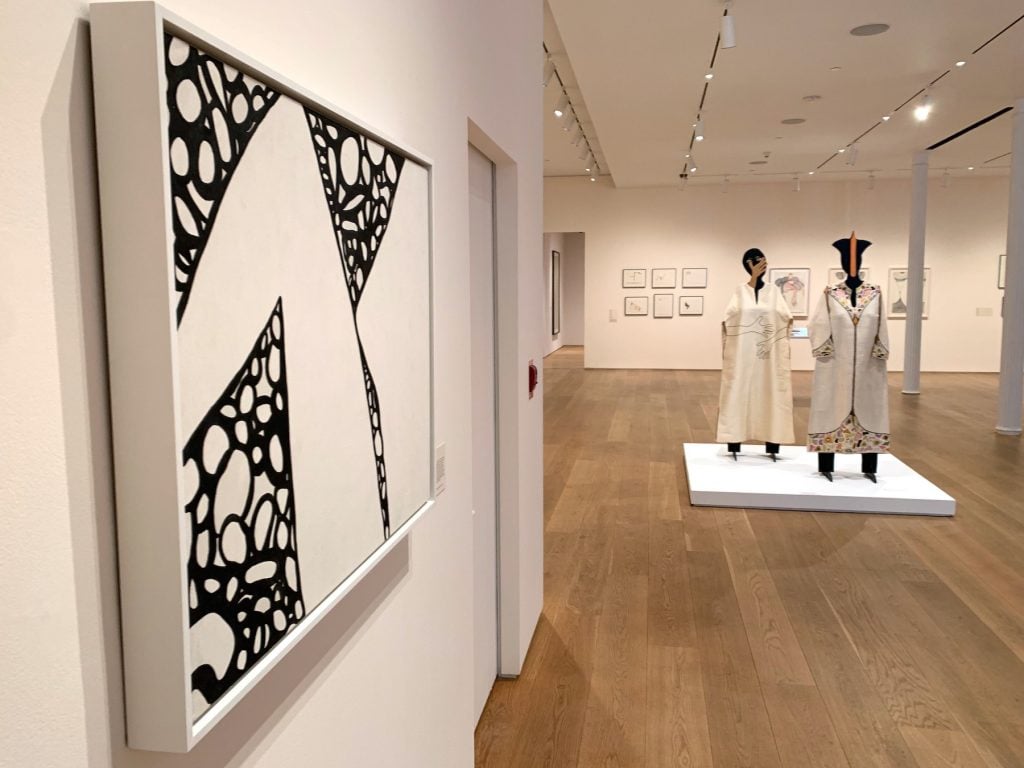
“Huguette Caland: Tête-à-Tête” looks at an artist who is also the daughter of one of Lebanon's most famous politicians.

Ben Davis

There’s plenty to say about Huguette Caland, on the occasion of “Huguette Caland: Tête-à-Tête” at the Drawing Center, a lovely (if too small) survey of her career, curated by Claire Gilman and Isabella Kapur.
Caland is an increasingly important figure in recent art history, her rise coinciding both with a surge of interest in overlooked women artists and the mounting political instability in her country of birth, Lebanon, which has put a spotlight on its history and culture. After a lifetime of mainly minor successes (she died in 2019), her reputation sharply spiked in her final years, during which she was celebrated in the “Made in L.A.” biennial in 2016, the Venice Biennale in 2017, and at the Tate St. Ives and the Sharjah Biennial in 2019.
Elegant and free spirited, Caland was a painter, sometimes sculptor, and designer of arty kaftans. Her paintings and drawings—and, indeed, even her kaftans—have an often frank, surrealist-tinged eroticism, featuring interlocking body parts and faces emerging from tangles of lines.
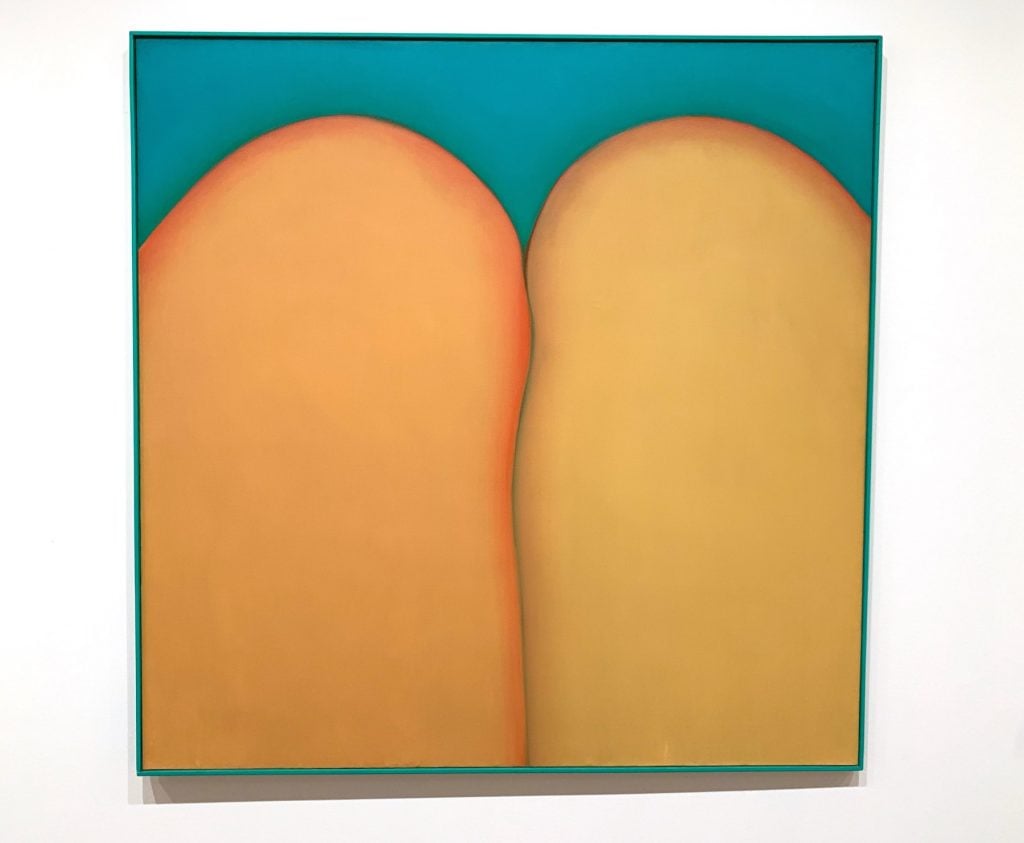
Huguette Caland, Bribes de Corps (Body Bits) (1973). Photo by Ben Davis.
If I were going to write a review of the show, I would say that its best works were the “Bribes de Corps” or “Body Bits” paintings of the early to mid ‘70s. These feature curvaceous, colored shapes, given just enough definition to make you understand that they double as up-close rolls of flesh, bodies smooshed together or zoomed in on. After that, I like her late-period abstractions, intricate, richly colored grids of interlocking patterns inspired by Palestinian textiles.
But I’ve been reading everything available about Huguette Caland for a week, and I am left a bit vexed. So instead of writing an ordinary review I decided that the most interesting question raised by the show is about how her life story gets told, and what is left out, and why.
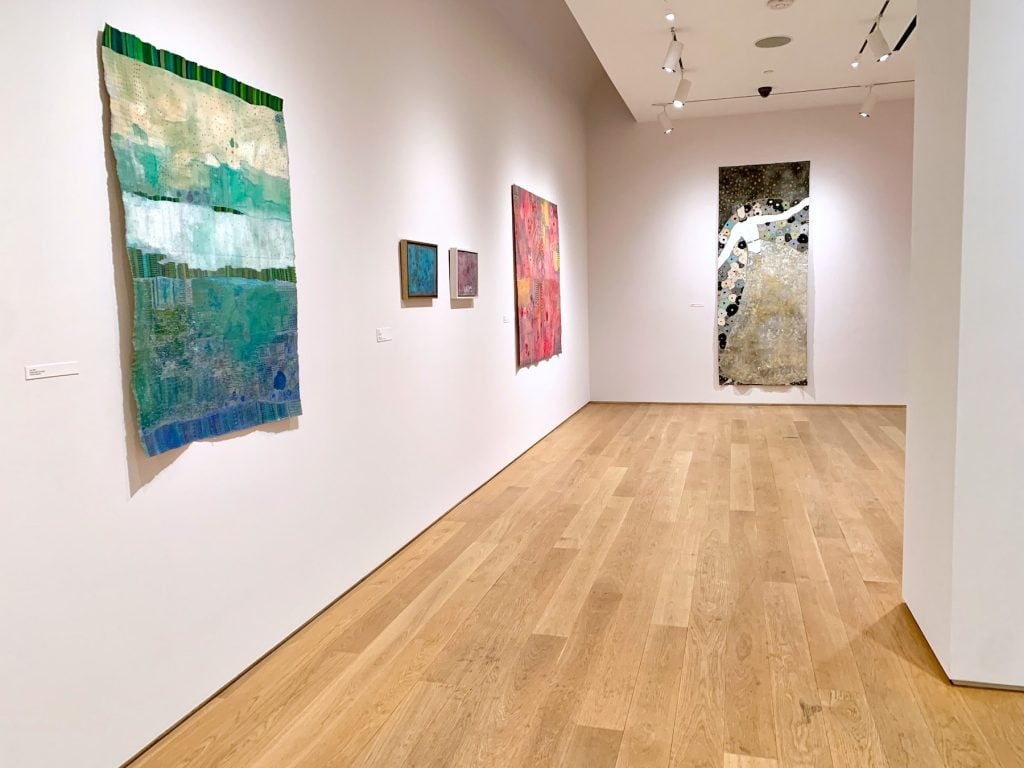
Installation view of “Huguette Caland: Tête-à-Tête” at the Drawing Center. Photo by Ben Davis.
All accounts of Huguette Caland’s life story contain the same important piece of background info: That she is the daughter of Bechara el-Khoury, a towering political figure and the first president of independent Lebanon in 1943.
El-Khoury is often described in the writing about Caland as a “national hero”—which is certainly true. Lebanon’s independence day celebrates the day he and other leaders were released from prison by the French authorities in 1943; Huguette had her first one-person show, in 1970, at an art center located on “Bechara el-Khoury Avenue.”
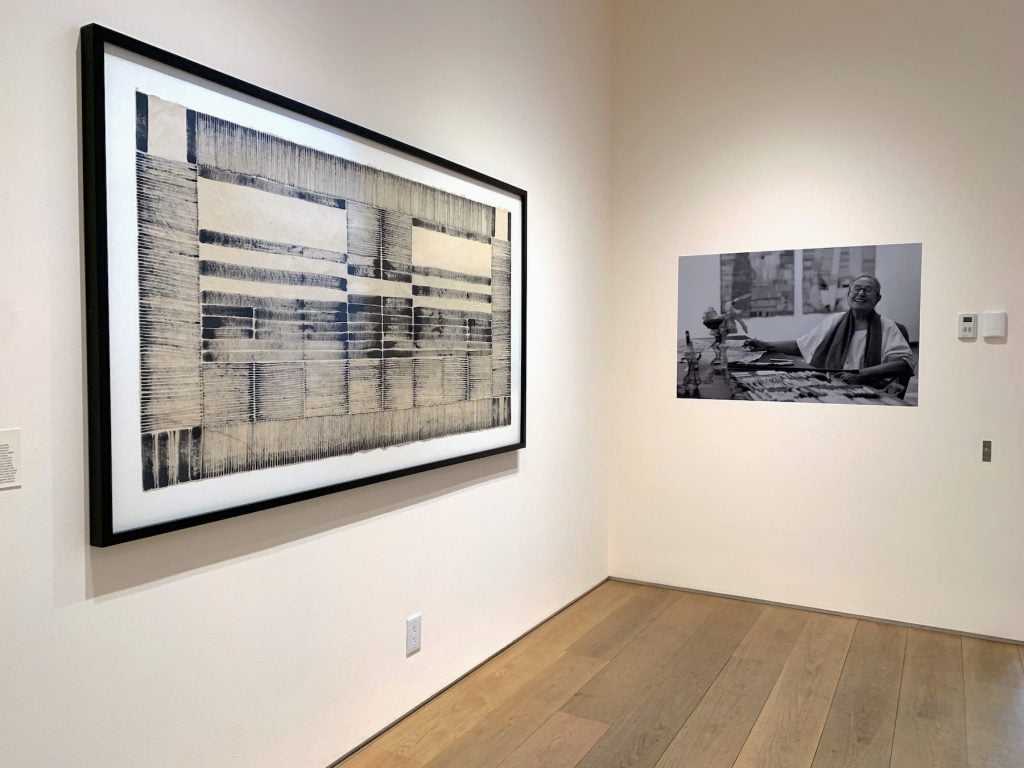
Installation view of “Huguette Caland: Tête-à-Tête” at the Drawing Center, featuring a portrait of the artist. Photo by Ben Davis.
But his legacy, it seems, was also somewhat tarnished by the circumstances of the end of his tenure. In everything I have read about Caland, I find no mention of how he fell from power, or what it might have meant to her. (In the most authoritative English essay about Caland’s early life, from the monograph Everything Takes the Shape of a Person, critic Kaelen Wilson-Goldie deals with this moment in a single parenthetical statement: “his nine-year-term as president had ended in 1952.”)
It may be that, given the suffering of Lebanon in subsequent decades, the upheaval of ‘52 has come to seem quaint. But it was not obscure, the first national crisis of the young nation. Bechara el-Khoury and the circle around him had become increasingly associated with corruption and nepotism. As one book put it, the family had become known for having “a finger in every business deal and every senior governmental appointment and realizing money from both.” Among other things, Huguette’s mother was caught taking $100,000 in gold to Paris, an embarrassment that was denounced in parliament, opening the floodgates of scandal.
Opposition factions united against him. A general strike paralyzed the country. El-Khoury appealed to the military to crush the rebellion.
When the military refused, in what is to this day remembered as a heroic act of neutrality, Bechara el-Khoury gave up power in the peaceful Rosewater Revolution. Huguette was 20.
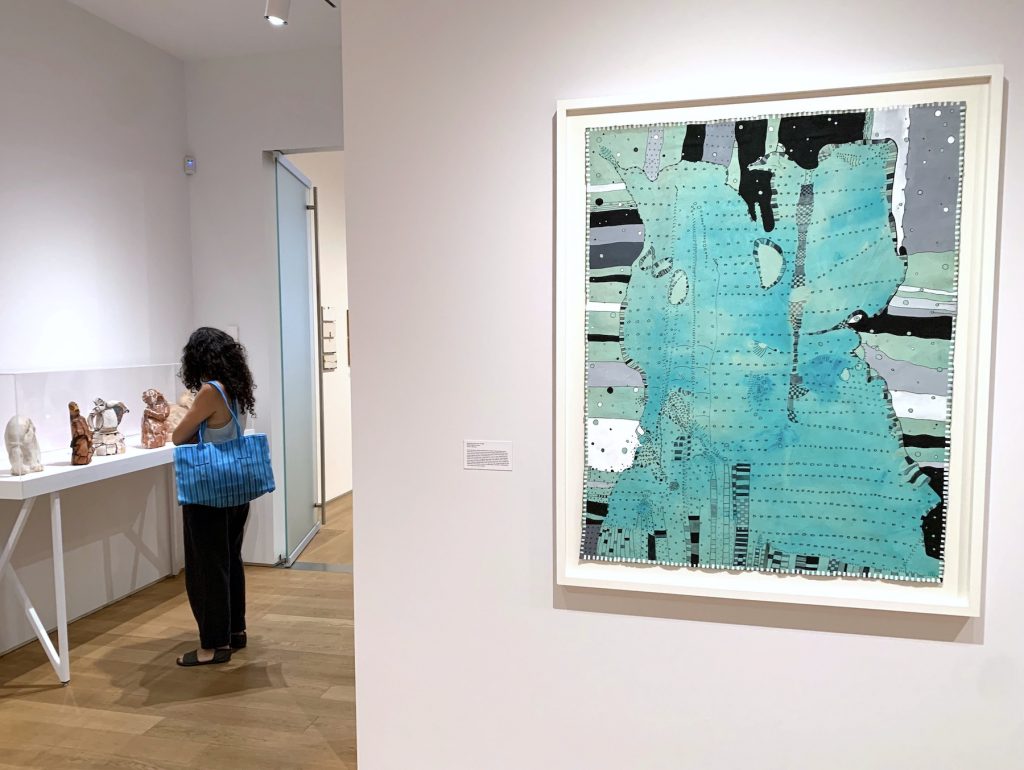
Installation view of “Huguette Caland: Tête-à-Tête” at the Drawing Center. Photo by Ben Davis.
This drama predates Huguette’s becoming an artist by more than a decade. The very same year her father had to give up the presidency, 1952, she married Paul Caland, a young French-Lebanese lawyer and nephew of publisher Georges Naccache, a fierce critic of her father, connected to yet another exceptionally influential Maronite Christian family. (The two families were associated with rival political newspapers; Naccache had been thrown in prison in 1949 for an article saying—prophetically—that the system of political compromises that el-Khoury had founded the nation on was too fragile to last.)
They both soon took lovers, even as they had three children, Pierre, Philippe, and Brigitte. Bechara el-Khoury would die of cancer in 1964, with Huguette helping to nurse him at the family estate outside of Beirut. It was only then that she seriously thought of being an artist, enrolling in her mid-30s to study art at American University, constructing a personal studio to work on her family estate, and changing her entire look.
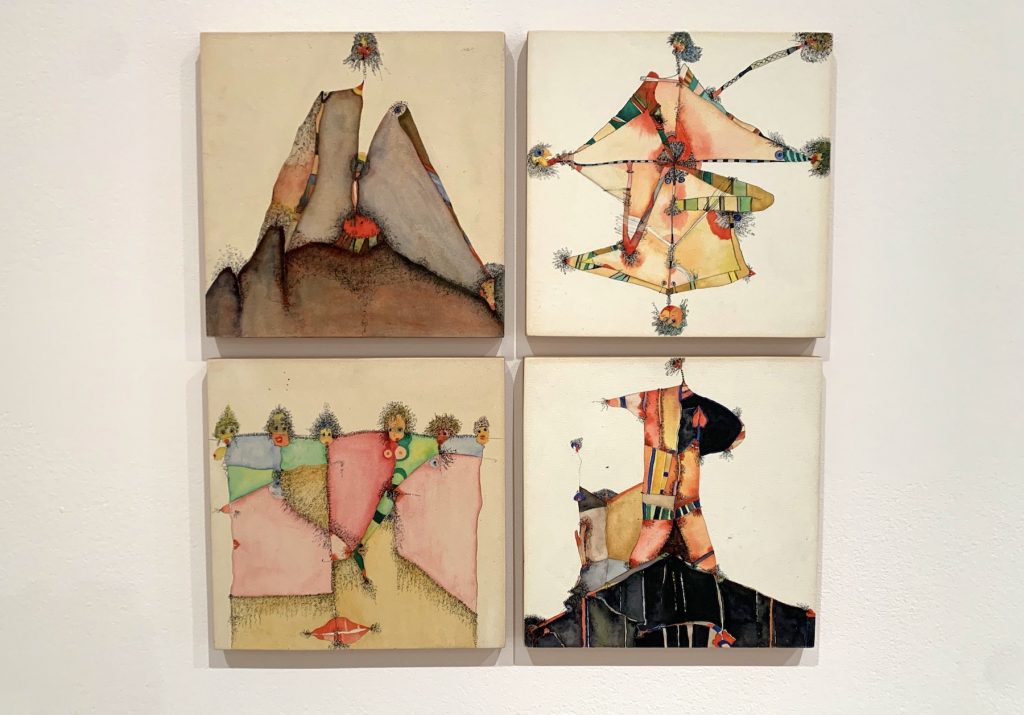
Huguette Caland, works from the “Homage to Public Hair” series (1992). Photo by Ben Davis.
Huguette had always struggled with her weight, and decided now to cease wearing Western fashions and to take up the loose-fitting abaya as more suitable to her shape. Her husband hated the change, calling them “sacks of potatoes.” Acquaintances in Lebanese society were said to think that “Sheikh Bechara’s daughter became crazy.”
In 1970, at the age of 39, Huguette Caland would abruptly leave her husband, her three children, and Lebanon, moving to Paris to live as an artist. The unconventional midlife turn was a dramatic act of self-realization and self-creation. “I wanted to have my own identity,” Caland said of her decision to seek an artist’s life abroad. “In Lebanon, I was the daughter of, wife of, mother of, sister of. It was such a freedom, to wake up all by myself in Paris. I needed to stretch.”
At the same time, she would remember that the deliberate estrangement was made easier because she saw her children often, given that they traveled as official swimming champions on the French national team, representing the former colonial power—her son Pierre Caland swam for France at the 1972 Munich Olympics. (Pierre went on to become a financier. Her other son, Philippe, became a film producer, making the infamous Hollywood disaster Boxing Helena, and touching off an international protest by Buddhist monks for his movie Hollywood Buddha—a film that features Huguette in the role of “mom.” Daughter Brigitte teaches Semitic languages at American University, is a chef, and, since 2005, has managed her mother’s legacy.)
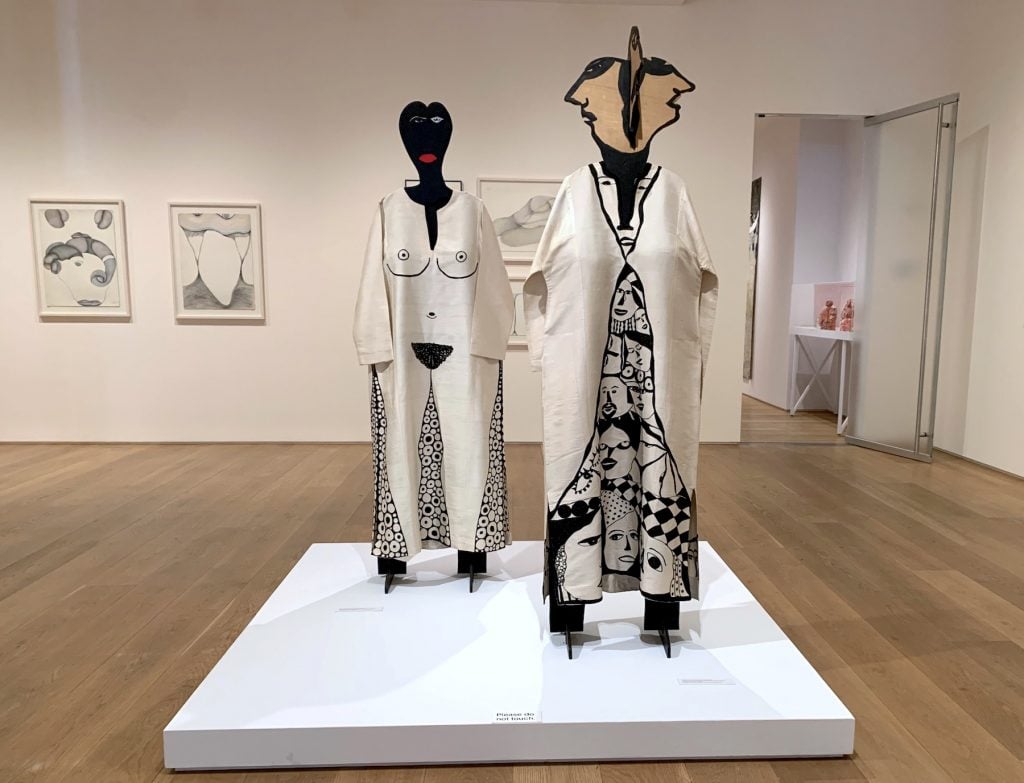
Installation view of “Huguette Caland: Tête-à-Tête” at the Drawing Center. Photo by Ben Davis.
In Paris, Caland deepened her explorations into erotic abstraction. She also, famously, met fashion designer Pierre Cardin who, liking her billowy, self-decorated clothing, had her design “Nour,” a line of kaftans (four of these unique creations are shown in the Drawing Center on custom, surrealist mannequins). “It was the only job I ever had in my life,” she boasted. I haven’t been able to find any explanation of how she lived as an artist who had only a handful of shows and proudly only did paid work a single time, but I assume that family money was somehow involved.
In the late ’80s, following the death of a lover, Romanian sculptor George Apostu, she would move to California. There, she had an architect build her a luxurious “chateau fort,” constructed with no interior walls—not even around the bedroom or bathroom. (A 2003 L.A. Times story about the house’s delightful architecture won Caland some of her first major press in English.) She held court there, made friends in the local artist community, and perfected radiant, free-flowing abstractions that captured her restless, happy temperament.
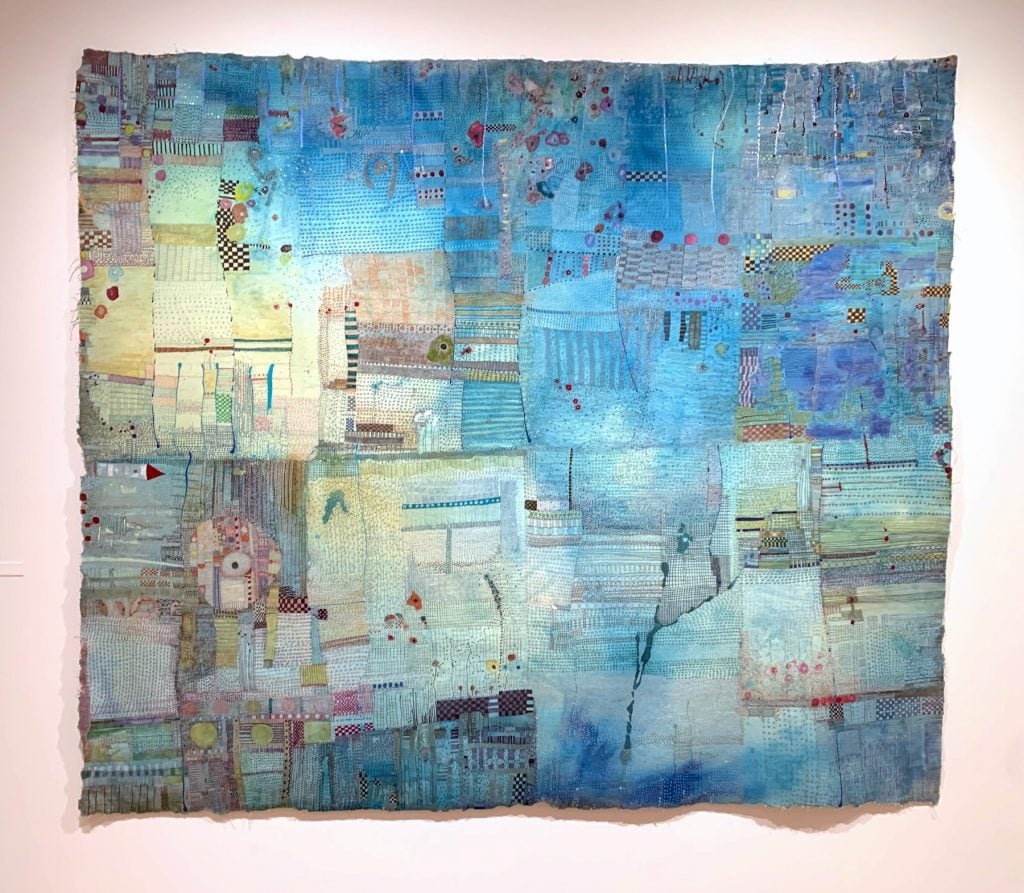
Huguette Caland, Bodrum (2008). Photo by Ben Davis.
In 2013, at 82, she returned to Beirut to attend to the sick Paul Caland, with whom she had never lost touch.
One aspect of Caland’s career that doesn’t get enough attention—perhaps her clearest act of commitment to a cause—was the founding of INAASH, a United Nations NGO, in 1969. The still-existing organization helps Palestinian women living in refugee camps within Lebanon learn traditional embroidery and sell it. This may seem like an aside here, but it’s relevant in that Palestinian embroidery patterns inspired Caland’s beautiful late work.
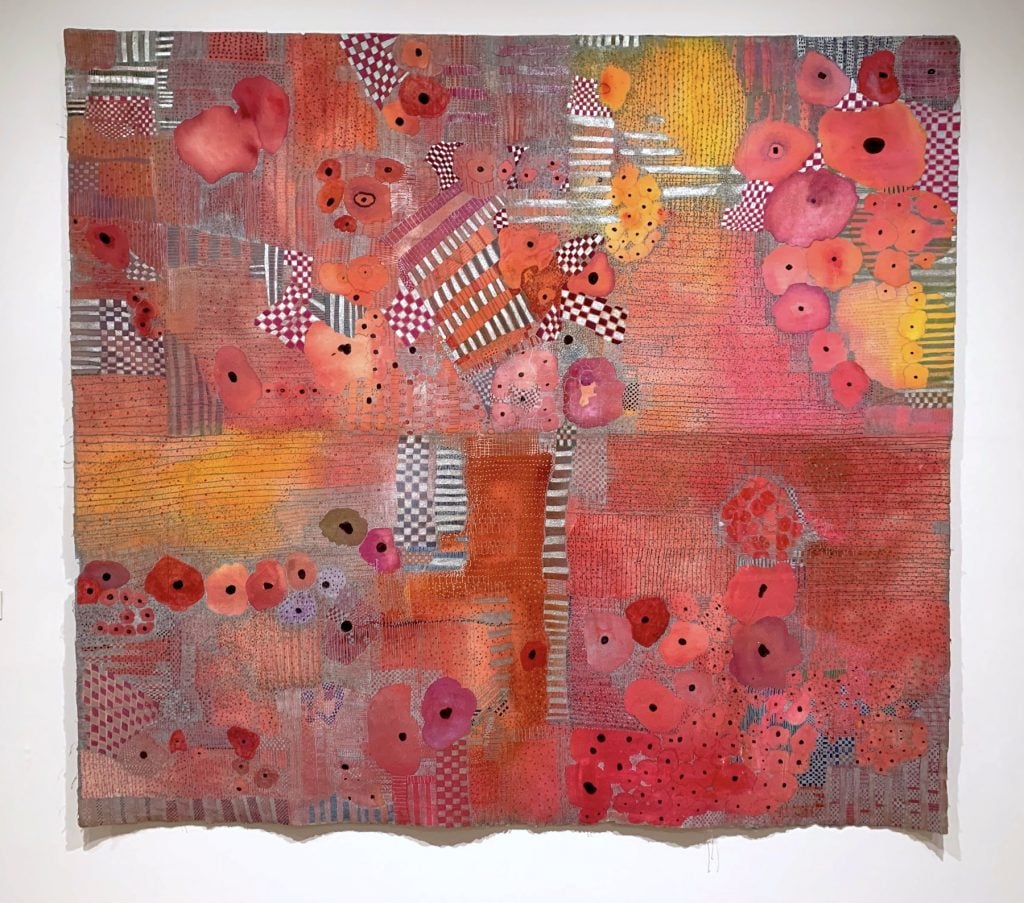
Huguette Caland, Appleton (2009). Photo by Ben Davis.
Many accounts give “Huguette El-Khoury Caland” sole credit for the organization, touting her influence as the daughter of the former president. Others mention two other women, Shermine Hneine and Gebran Majdalani, and say that a Palestinian, Serene Husseini Shahid, convinced these doyennes of Lebanese society to focus the organization on preserving Palestinian embroidery traditions after being enraged to see Palestinian textiles being sold as “Israeli” in New York.
By all accounts, Caland was moved by the plight of Palestinians displaced from their homeland. She reportedly had two busses of refugees brought to see her 1970 show at Dar El Fan art center.
Three and a half decades later, in 2006, a curator’s glimpse of Palestinian embroidery on pillows in Caland’s luxurious Venice home would inspire the Los Angeles Craft and Art and Folk Art Museum to do “Sovereign Threads: A History of Palestinian Embroidery,” with Caland helping to fund the show and make the curatorial connections.
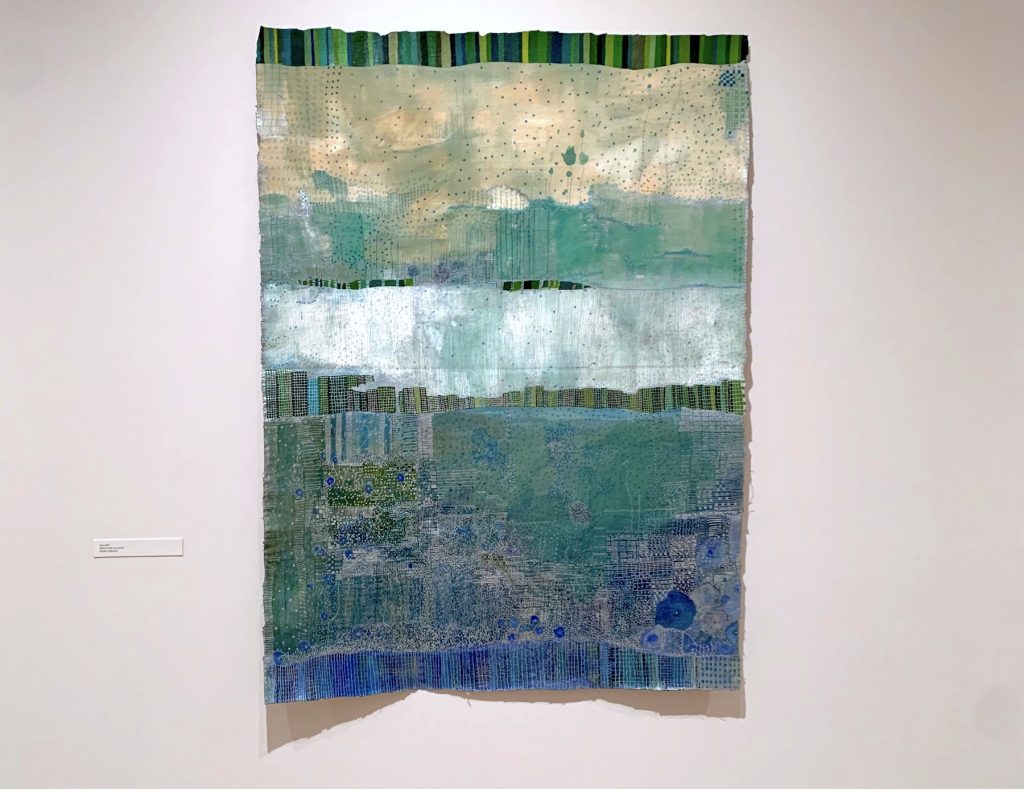
Huguette Caland, City (2010). Photo by Ben Davis.
But the state of the available writing on Caland is such that I’m not quite sure, after days of reading, how one squares the narrative of her commitment to refugee women via INAASH with the narrative of her making a clean break with her responsibilities in a feminist act of self-invention for Paris—something that happened directly after the NGO’s founding. I’d like to know more!
On a Lebanese arts-and-culture chat show some years ago, daughter Brigitte Caland was asked what her famous mother would want an audience to take away from her work. “To like her art without thinking about a nationality or gender,” was the reply.
This is likely not a line that resonates with most of Caland’s fans just now, smacking of a dated universalism that directly contradicts the feminist and post-colonial types of criticism that have helped elevate her legacy in recent years. For me, that’s the reason to interrogate her biography a bit, because her personal story is explicitly being used to lend its aura to the art.

Huguette Caland, works from the “Homage to Public Hair” series (1992). Photo by Ben Davis.
The Drawing Center is playing the informative documentary, Huguette Caland: Outside the Lines (produced by Brigitte). In it, Kaelen Wilson-Goldie (who also reviewed the show) admits that Caland didn’t want to be called a feminist. “But it’s what you want out of feminist art which is seeing feminism in action, which is how you live your day to day,” she says.
Caland was certainly a fascinating character, living on her own terms, embracing sexual and creative freedom far in advance of what was on offer. At the same time, contemporary feminist theory has labored mightily to get out from under the class- and race-blind rhetoric that inflected the largely white, largely middle-class Second Wave in the ‘70s in the U.S. A contemporary intersectional approach, it seems to me, needn’t deny the substance of her rebellion, but might put some more focus on clarifying how Caland’s specific social position, coming from the very literal ruling class of a nation, gave her access to forms of self-actualization that most women didn’t and don’t have.
The habit of invoking her family’s political status, but in a purely mythologizing way, is more vexing—particularly right now.
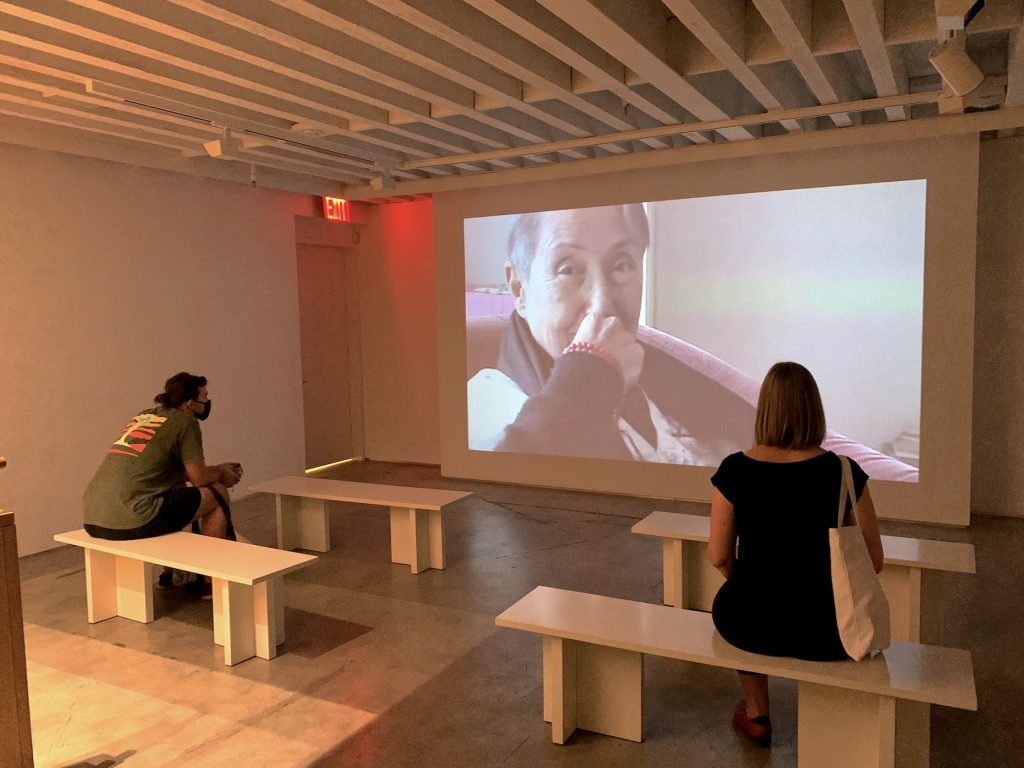
Viewers watch Letters to Huguette at the Drawing Center. Photo by Ben Davis.
A second film at the Drawing Center, the meditative Letters to Huguette by great Lebanese photographer Fouad Elkoury, explicitly seeks to connect Huguette Caland’s seemingly self-focused artistic philosophy and today’s general interest in activism. It juxtaposes interviews of the elderly artist talking about her painting practice with images of the earth-shaking 2019 street protests in Beirut and then the near-collapse of the country under coronavirus in 2020.
Speaking of one young street protester, the narrator addresses himself to Caland: “just like you, he wants to affirm the rights of the individual.” The protesters on the streets, we are told, will “inevitably echo your own fight for freedom”—a heartfelt but odd tribute that seems to compare young people literally occupying the streets in collective political action to Caland leaving the country to pursue her passions on her own.
The film strikes a completely different note from the erotic fragments and sunnily abstract works we see in the actual show.
Letters to Huguette symbolically links Caland’s art to the spirit of contemporary protest by showing her talking about the fear she felt as a girl when her father was a pro-Lebanese independence activist being harassed by the French authorities. But isn’t it even slightly relevant, in the context of a film about anti-corruption protests, that her father was himself once targeted by anti-corruption protests?
The film briefly mentions, in one line, that Bechara el-Khoury himself designed the dysfunctional political system based on institutionalized religious division that the protesters are trying to tear down, while Huguette personally disapproved of this system—but the tension is not really explored. When the film shows us Huguette Caland holding forth on politics, she basically says that people from different backgrounds should get along. (Her daughter and advocate Brigitte stated on that chat show quite clearly, “She was born in a political house but I don’t think politics mattered to her.”)
To be clear: I like Huguette Caland’s art and I like this show! What I am getting at, anyway, is a much larger pattern: art history has a tendency to default to notions of artists as heroes, and to turn art into an all-purpose form of social wisdom. And so, because we like Caland’s work and want to make the case for it, the parts of her biography that resonate with contemporary narratives are emphasized, and anything that complicates the picture is deemphasized.
But isn’t it better—either to understand her art or to understand the forces shaping our own world—to emphasize that artists are not in any intrinsic way heroic, but people who are sometimes relatable and insightful, but often privileged or compromised, and sometimes inspiring, but not always in ways that you either could or would want to follow? How unfortunate an irony would it be if the very act of bringing a Lebanese artist into the center of art history becomes a way to create a subtly skewed view of Lebanese history?
“Huguette Caland: Tête-à-Tête” is on view at the Drawing Center, New York, through September 19, 2021.